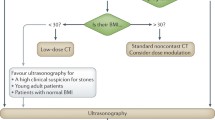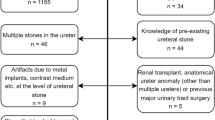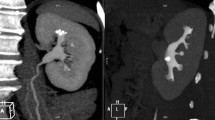Abstract
When it comes to the treatment of kidney stones, imaging is a crucial diagnostic tool, and the very first step in determining which therapeutic choices to utilize is vitally significant. Non-contrast CT of the abdominal area routinely delivers the best precise test but also exposes patients to ionizing radiation as a result of the procedure. Ultrasonography has traditionally had lesser sensitivity and accuracy than computed tomography (CT), but it does not involve radiation use. These imaging modalities, on the other hand, were shown to have equal diagnostic accuracy when compared to a randomized controlled experiment, which was conducted in an emergency department. Both modes of transportation have their pros as well as downsides. In patients with established stone illness, plain film radiography of the kidney, ureter, as well as bladder (KUB) is the most appropriate imaging technique for assessing interval stone development. It is less beneficial in the context of acute stones, however. Although magnetic resonance imaging (MRI) allows for 3D imaging without the use of radiation, it is both expensive and hard to see stones at this time. The examination of kidney disease is thus a critical aspect of the research into nephrolithiasis to better comprehend the function of trace components in the production of kidney stones as well as to develop future methods for management and prophylaxis of stone formation as well as recurrence. The purpose of this study is to examine methods and procedures that are routinely utilized in the evaluation of urinary calculi. And along with this, a cheap and non-radiation technology can be developed by improving the techniques, methods, and algorithms being used so far.
Access this chapter
Tax calculation will be finalised at checkout
Purchases are for personal use only
Similar content being viewed by others
References
Coe FL, Evan A, Worcester E (2005) Kidney stone disease. J Clin Investig 115(10):2598–2608
Grases F, Costa-Bauza A, Prieto RM (2006) Renal lithiasis and nutrition. Nutr J 5(23):1–7
Romero V, Akpinar H, Assimos DG (2010) Kidney stones: a global picture of prevalence, incidence, and associated risk factors. Rev Urol 12(2–3):86–96
HPCS (2002) Scanning systems, computed tomography, full-body, healthcare product comparison system (HPCS). ECRI Institute
Chan V, Perlas A (2011) Basics of ultrasound imaging. In: Atlas of ultrasound-guided procedures in interventional pain management. Springer, New York, 2011, pp 13–19
Asadi S, Hassanpour H, Pouyan A (2010) Texture based image enhancement using gamma correction. Middle-East J Sci Res 6(6):569–574
Gonzalez RC, Woods RE (1992) Digital image processing, 2nd edn, Ch. 2, pp 47–51 and Ch. 10, pp 568–611
Bazin D, Daudon M, Chevallier P, Rouziere S, Elkaim E, Thiaudiere D, Fayard B, Foy E, Albouy PA, André G, Matzen G, Veron EAnn Biol Clin (Paris). 2006 64(2):125–39
Daudon M, Bazin D (2013) (2013) When the Synchrotron radiations highlight the Randall’s plaques and kidney concretions. J Phys: Conf Ser 425:022006
Kasidas GP, Samuell CT, Weir TB (2004) Renal stone analysis: why and how? Ann Clin Biochem 41(Pt 2):91–97
Lee HP, Leong D, Heng CT (2012) Characterization of kidney stones using thermogravimetric analysis with electron dispersive spectroscopy. Urol Res 40(3):197–204
Douglas DE, Tonks DB (1979) The qualitative analysis of renal calculi with the polarising microscope. Clin Biochem 12(5):182–183
Schubert G (2006) Stone analysis. Urol Res 34(2):146–150
Coursey CA et al (2012) ACR appropriateness criteria(R) acute onset flank pain-suspicion of stone disease. Ultrasound Q 28:227–233
Memarsadeghi M et al (2005) Unenhanced multi-detector row CT in patients suspected of having urinary stone disease: effect of section width on diagnosis. Radiology 235:530–536
Schwartz BF, Schenkman N, Armenakas NA, Stoller ML (1999) Imaging characteristics of indinavir calculi. J Urol 161:1085–1087
Erwin BC, Carroll BA, Sommer FG (1984) Renal colic: the role of ultrasound in initial evaluation. Radiology 152:147–150
Asrat T, Roossin MC, Miller EI (1998) Ultrasonographic detection of ureteral jets in normal pregnancy. Am J Obstet Gynecol 178:1194–1198
Worster A, Preyra I, Weaver B, Haines T (2002) The accuracy of noncontrast helical computed tomography versus intravenous pyelography in the diagnosis of suspected acute urolithiasis: a metaanalysis. Ann Emerg Med 40:280–286
Fulgham PF, Assimos DG, Pearle MS, Preminger GM (2013) Clinical effectiveness protocols for imaging in the management of ureteral calculous disease: AUA technology assessment. J Urol 189:1203–1213
Thomson JM, Glocer J, Abbott C, Maling TM, Mark S (2001) Computed tomography versus intravenous urography in diagnosis of acute flank pain from urolithiasis: a randomized study comparing imaging costs and radiation dose. Australas Radiol 45:291–297
Johnston R, Lin A, Du J, Mark S (2009) Comparison of kidney-ureter-bladder abdominal radiography and computed tomography scout films for identifying renal calculi. BJU Int 104:670–673
Ege G, Akman H, Kuzucu K, Yildiz S (2004) Can computed tomography scout radiography replace plain film in the evaluation of patients with acute urinary tract colic? Acta Radiol 45:469–473
Bishoff JT, Rastinehad AR (2006) In: Wein AJ, Kavoussi LR, Partin AW, Peters CA (eds) Campbell-Walsh urology, vol 1. Elsevier, pp 26–62
Karabacakoglu A, Karakose S, Ince O, Cobankara OE, Karalezli G (2004) Diagnostic value of diuretic-enhanced excretory MR urography in patients with obstructive uropathy. Eur J Radiol 52:320–327
Robson MD, Gatehouse PD, Bydder M, Bydder GM (2003) Magnetic resonance: an introduction to ultrashort TE (UTE) imaging. J Comput Assist Tomogr 27:825–846
Yassin A et al (2012) In vitro MR imaging of renal stones with an ultra-short echo time magnetic resonance imaging sequence. Acad Radiol 19:1566–1572
Mullins JK, Semins MJ, Hyams ES, Bohlman ME, Matlaga BR (2012) Half Fourier single-shot turbo spin-echo magnetic resonance urography for the evaluation of suspected renal colic in pregnancy. Urology 79:1252–1255
Coursey CA, Nelson RC, Boll DT, Paulson EK, Ho LM, Neville AM, Marin D, Gupta RT, Schindera ST (2010) Dual-energy multidetector CT: how does it work, what can it tell us, and when can we use it in abdominopelvic imaging? Radiographics 30(4):1037–1055
Akkasaligar PT, Biradar S, Kumbar V (2017) Kidney stone detection in computed tomography images. In: 2017 International conference on smart technologies for smart nation (SmartTechCon)
Ebrahimi S, Mariano Image VY (2015) Quality improvement in kidney stone detection on computed tomography images. J Image Gr 3(1)
Thein N, Nugroho HA, Adji TB, Hamamoto K (2018) An image preprocessing method for kidney stone segmentation in CT scan images. In: 2018 International conference on computer engineering, network and intelligent multimedia (CENIM)
Tamilselvi PR, Thangaraj P (2011) Computer aided diagnosis system for stone detection and early detection of kidney stones. J Comput Sci 7(2):250–254
Kalyan K, Jain S, Lele RD, Joshi M, Chowdhary A (2013) Application of artificial neural networks towards the determination of presence of disease conditions in ultrasound images of kidney. Int J Comput Eng Technol 4:232–243
Yildrim K, Bozag PG, Talo M, Yildrim O, Karabatak M, Rajendra Archarya U (2021) Deep learning model for automated kidney stone detection using coronol CT images
Vishnu Prasad GP, Reddy KVS, Kiruthik AM, Arun Nehru J (2022) Prediction of kidney stones using machine learning, 2321-9653
Hu S et al (2017) Towards quantification of kidney stones using X-ray dark-field tomography. In: 2017 IEEE 14th International symposium on biomedical imaging (ISBI 2017), Melbourne, VIC, 2017, pp 1112–1115. https://doi.org/10.1109/ISBI.2017.7950711
Singh S, Srivastava D, Agarwal S (2017) GLCM and its application in pattern recognition. In: IEEE 2017 5th international symposium on computational and business intelligence (ISCBI), Dubai, 2017, pp 20–25
Viswanath K, Gunasundari R (2015) Analysis and implementation of kidney stone detection by reaction diffusion level set segmentation using Xilinx system generator on FPGA. VLSI Design/2015
Aadhirai S, Jamal DN (2017) Feature extraction and analysis of renal abnormalities using fuzzy clustering segmentation and SIFT method. In: IEEE 2017 third international conference on biosignals, images and instrumentation (ICBSII), Chennai, 2017, pp 1–5
Ranjitha M (2016) Extraction and dimensionality reduction of features for Renal Calculi detection and artifact differentiation from segmented ultrasound kidney images. In: IEEE 2016 3rd international conference on computing for sustainable global development (INDIACom), New Delhi, 2016, pp 3087–3092
Palaniappan S, Awang R (2008) Intelligent heart disease prediction system using data mining techniques. In: IEEE/ACS international conference on computer systems and applications, 2008. AICCSA 2008, pp 108–15. IEEE
Hosmer Jr DW, Lemeshow S, Sturdivant RX (2013) Applied logistic regression. Wiley
Joachims T (1998) Making large-scale SVM learning practical. SFB 475: Komplexitätsreduktion Multivariaten Datenstrukturen, Univ. Dortmund, Dortmund, Tech. Rep, p 28
Quinlan JR (1986) Induction of decision trees. Mach Learn 1(1):81–106
Cruz JA, Wishart DS (2006) Applications of machine learning in cancer prediction and prognosis. Cancer Informat 2:59–77
Breiman L (2001) Random forests. Mach Learn 45(1):5–32
. Lindley DV (1958) Fiducial distributions and Bayes’ theorem. J Royal Stat Soc Ser B (Methodol) 1:102–107
Rish I (2001) An empirical study of the naive Bayes classifier. In: IJCAI 2001 workshop on empirical methods in artificial intelligence, vol. 3, 22. IBM, New York, pp 41–46
Author information
Authors and Affiliations
Corresponding author
Editor information
Editors and Affiliations
Rights and permissions
Copyright information
© 2023 The Author(s), under exclusive license to Springer Nature Singapore Pte Ltd.
About this paper
Cite this paper
Buri, S., Shrivastava, V. (2023). A Brief Review of Kidney Stone Detection and Prediction Techniques. In: Kumar, S., Hiranwal, S., Purohit, S., Prasad, M. (eds) Proceedings of International Conference on Communication and Computational Technologies. ICCCT 2023. Algorithms for Intelligent Systems. Springer, Singapore. https://doi.org/10.1007/978-981-99-3485-0_42
Download citation
DOI: https://doi.org/10.1007/978-981-99-3485-0_42
Published:
Publisher Name: Springer, Singapore
Print ISBN: 978-981-99-3484-3
Online ISBN: 978-981-99-3485-0
eBook Packages: Intelligent Technologies and RoboticsIntelligent Technologies and Robotics (R0)




